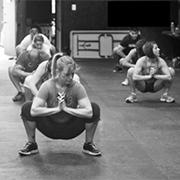
Instead of worshiping in old wooden church pews, Millennials are jumping on top of wooden boxes until exhaustion at CrossFit affiliates, and it's not just to replace a trip to church with a workout.
Millennials make up a significant portion of the religiously unaffiliated population and they are joining non-secular organizations that blend a sense of community, a sense of self awareness, and, dare say it, a resemblance of religion, according to a study called "How We Gather" researched by two Harvard Divinity School students.
"We are offering a challenge, and this is more of a challenge to the world of religion, that if you think religion is dying, we are saying religion is changing," said Casper ter Kuile, co-author of the study.
Millennials—the generation of 18-to-34 year olds—are not practicing religion the same way their parents and grandparents did. According to a Pew Research Center study, more than one-third of Millennials are not affiliated with a religion, which is double the amount of Baby Boomers who identify as unaffiliated. Additionally, another Pew study released this week indicated that about one-quarter of American Millennials say they attend religious services on a weekly basis, and about half say they believe in God with absolute certainty, compared with seven-in-ten Americans in the Silent and Baby Boomer generations.
These were trends that Angie Thurston, co-author of "How We Gather," started to notice before she came to Harvard. She began charting the organizations that Millennials are joining to find a deeper sense of community. When she came to the HDS, she met ter Kuile, who is training to become a minister for non-religious people, and that small spreadsheet turned into a brainstorm of more than 100 different institutions and organizations.
That's when they decided to get to work on their research.
"By the time we had about 100 organizations, we thought, 'OK, maybe we should talk to some of these people,' " Thurston said.
What they found were many common threads and themes when speaking to leaders of these organizations. At CrossFit—a worldwide workout phenomenon with 4 million users—the members exhibit a close-knit community of people trying to better themselves and those around them through physical fitness. Members have organized fundraisers and other drives to aid friends and other CrossFitters who are going through sickness and other extraordinary circumstances.
Greg Glassman, CEO of CrossFit, spoke at HDS on Thursday, November 5, about the connection his organization has to finding meaningful communities outside of the church.
At The Dinner Table—a group of 20 to 30-somethings who get together over a homemade dinner to discuss personal loss—the members begin to heal by creating a safe place to talk about feelings and emotions.
Thurston and ter Kuile selected 10 organizations to study more closely using six different themes: community, personal transformation, social transformation, purpose finding, creativity, and accountability.
"What you will see among young people is that they are indeed participating in communities and they are in communities that are some ways mirroring the function that religious communities have served," Thurston said. "These are communities that are helping people aspire toward goals, transform themselves, and work toward change while holding each other accountable to make things better. They are inspiring creativity and inspiring people to find their purpose and mission in life. All these kinds of key functions that a community can serve."
Getting some of the organizations' leaders to grasp the research and questions was a bit difficult at first, according to ter Kuile. Several leaders got the connection right away, while others needed time to think about how their work might possibly mirror religion and deep community building.
He said that CrossFit, which is talked about in and out of its circles as a cult-like way for people to work out, was on board immediately with the ideas.
The work that Thurston and ter Kuile are undertaking is ongoing as more and more community-based organizations like the ones they studied come into existence. The next step for the research is to find out if there is a responsibility for these organizations to become deeper parts of the community as more Millennials shift away from traditional religion.
"These things are actually religious. You should treat these institutions as religious options that people find," said ter Kuile. "That's a difficult thing to hear if you are a church or for other denominations. At the same time, it's exciting."
–by Tom Layman
